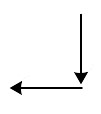9.3 方向
章节大纲
-
方向方向方向方向方向方向方向方向方向方向方向方向方向方向方向方向方向方向方向方向方向方向方向方向方向方向方向方向方向方向方向方向方向方向方向方向方向方向方向方向方向方向方向方向方向方向方向方向方向方向
Imagine traveling several miles in one of the directions indicated by this sign. Now suppose that a friend travels the same in another direction indicated by the sign. You and your friend would end up in very different locations. Obviously, direction is an important component of motion.
::想象一下这个标志所显示的方向之一行驶几英里。 现在假设一个朋友在标志所显示的另一个方向行驶相同。 你和你的朋友最终会到达非常不同的地点。 显然, 方向是运动的重要组成部分 。Introducing Direction
::介绍方向Direction is the location of something relative to something else. Direction can be described in relative terms that compare the position of something to another object, such as up, down, in, out, left, right, forward, backward, or sideways. Direction can also be described with the cardinal directions: north, south, east, or west. On maps, cardinal directions are indicated with a compass rose. You can see one in the bottom left corner of the map in the Figure . You can use the compass rose to find directions on the map. For example, to go to the school from Jordan’s house, you would travel from east to west. If you wanted to go on to the post office, you would change direction at the school and then travel from south to north.
::方向是某物的相对位置。 方向可以相对比较某物的位置, 比较某物的位置, 比如上、 下、 上、 上、 左、 右、 前、 前、 前、 或侧面。 方向也可以用主方向描述: 北、 南、 东、 西。 在地图上, 主方向用指南针表示。 您可以在图中看到地图左下角的一个方向 。 您可以使用指南针在地图上找到方向 。 例如, 从约旦的家到学校, 您会从东到西。 如果您想前往邮局, 您会改变学校的方向, 然后从南到北。Why Direction Is Important
::为何方向重要Look again at the map in the Figure . The distance from Jordan’s house to the post office is 3 km. But if Jordan told a friend how to reach the post office from his house, he couldn’t just say “go 3 kilometers.” The friend might end up at the park instead of the post office. Jordan would have to include direction as well as distance. He could say, “go west for 2 kilometers and then go north for 1 kilometer."
::再看看图中的地图。从约旦的房子到邮局的距离是3公里。 但如果约旦告诉朋友如何从他家到邮局,他就不能说“走3公里 ” 。 朋友可能最终会来到公园而不是邮局。 约旦必须包括方向和距离。 他可以说 , “ 往西走2公里,然后往北走1公里。 ”Launch the PLIX Interactive below and try to turn the path outlined on the map into a series of written directions:
::启动下面的 PLIX 互动, 尝试将地图上描述的路径转换成一系列书面方向 :Motion and Vectors
::运动和矢量When both distance and direction are considered, motion can be represented by a vector . A vector is a measurement that has both size and direction. It may be represented by an arrow. If you are representing motion with an arrow, the length of the arrow represents distance, and the way the arrow points represents direction.
::当考虑距离和方向时,运动可以由矢量代表。矢量既具有大小又具有方向。矢量可以由箭头代表。如果是箭头代表运动,则箭头的长度代表距离,箭头点代表方向的方式代表方向。The red arrows on the map in the Figure are vectors for Jordan’s route from his house to the school and from the school to the post office.
::地图上的红箭是约旦从家中到学校以及从学校到邮局的路线的矢量。Q: How would you draw arrows to represent the distances and directions from the post office to the park on the map in the Figure ?
::问题:您将如何绘制箭头来代表邮局到图中地图上的公园的距离和方向?A: The vectors would look like this:
::A:矢量看起来是这样的:Watch the video below to learn more about the differences between vectors and scalars demonstrated in a football play :
::更多了解在足球赛中显示的矢量和电弧之间的差异:Summary
::摘要-
Direction is the location of something relative to something else.
::方向是某物相对于某物的位置。 -
A compass rose shows cardinal directions, such as North, East, South, and West, on a map.
::玫瑰罗盘在地图上显示一些主要方向,如北、东、南和西。 -
A vector is a measurement with both size and direction and may be represented by an arrow. A vector can be used to represent both the distance and direction of motion.
::矢量是一种既大小又方向的测量,可以用箭头表示。矢量既可以用来代表运动的距离,也可以用来代表运动的方向。
Review
::回顾-
Think of a short route you commonly take, such as the route from your home to a friend’s house or your school. Describe the direction(s) and distance(s) you travel over this route.
::想想你通常走的捷径,例如从你家到朋友家或学校的路程。请描述您穿过这条路行驶的方向和距离。 -
What is a vector? How can an arrow represent distance and direction of motion?
::什么是矢量?箭头如何代表运动的距离和方向? -
Draw vectors to represent these motions:
-
moving 3 cm to the right
::向右移动 3 厘米 -
moving 2 cm to the left
::向左移动 2 厘米
::绘制矢量以代表这些运动:向右移动3厘米,向右移动2厘米,向左移动2厘米 -
moving 3 cm to the right
-
Direction is the location of something relative to something else.


